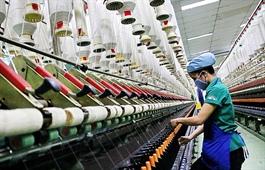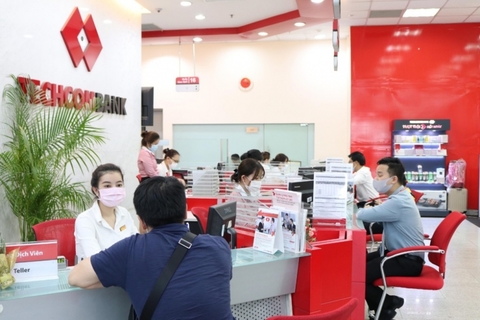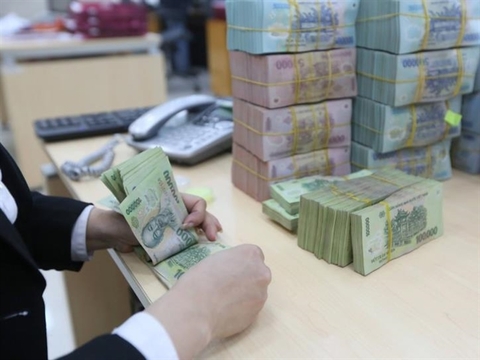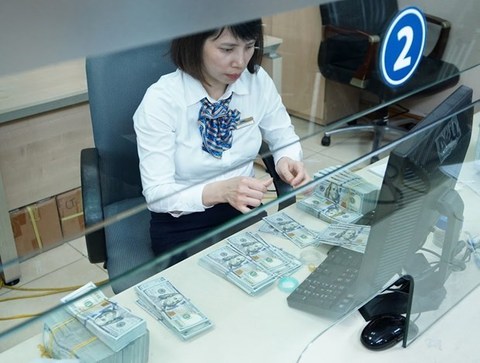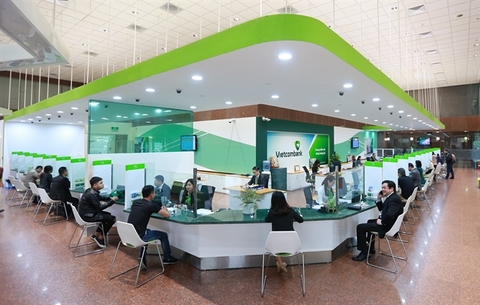Bad debts a burden for commercial banks
Bad debts a burden for commercial banks
Commercial banks are currently publishing their second quarter financial statements which are all showing very impressive results.
Illustrative photo. |
However, it is forecast that in the second half of the year it will be difficult for bank profits to rise strongly as the main factor for creating profit is credit room. At present credit room is decreasing and bad debts are set to increase, which will create a burden for provisioning.
Limited credit room
The numbers shown on the financial statements as well as via the bank announcement show that up to this point banks have had a good business season in the first half of the year. Up to now, Vietcombank is at the top in terms of profit in the entire banking industry, with Profit Before Tax (PBT) of VND 17,373 bln, up by 28% over the same period. VPBank ranks second with a PBT of VND 15,323 bln, up by 69.9%. Techcombank also continued to impress with a PBT of VND 14,107 bln, up by 22.3%.
Other commercial banks also reported good profits, such as the Saigon Hanoi Bank (SHB) stating that their six-month PBT reached nearly VND 5,900 bln, up by 84%; the LienVietPostBank reached VND 3,588.5 bln, up by 76%, equivalent to 74.7% of the year plan; the TPBank reached more than VND 3,787 bln, up by 26%; and the ABBANK reached VND 1,632 bln and completed 53% of the year plan. Small-scale joint stock commercial banks also saw a growth in PBT in the last part of the half year. BacABank recorded a PBT of VND 448 bln, up by 2.9% over the same period; the Viet Capital Bank reached VND 355 bln, up by 5%; the VietBank reached VND 387.7 bln, up by 18.9%; PGBank reached VND 245 bln, up by 40%; and the BaoVietBank PBT was at VND 25.5 bln, up by 51%.
Profits of banks are still accelerating impressively, but it is forecast that the absolute profit of banks in the last six months of the year may be lower than at the beginning of the year. This is because the State Bank of Vietnam views credit growth as quite tight. According to Governor Nguyễn Thị Hồng, the State Bank of Vietnam will keep this year-oriented credit target of about 14%, higher than the growth rate of 13.61% in 2021 and 12.17% in 2020. As of 30 June, credit has increased by 9.35%, higher than the increase of the first six months of 2021 and the years before the outbreak of the Covid-19 pandemic. This means that the remaining credit space for the last six months is not much, at only 4.65%.
Since the last two months, many banks have gradually run out of credit room due to the hot increase in the first months of the year. In previous years, around June, the State Bank of Vietnam would loosen the credit room, but this year this has not been the case, even though commercial banks have used the excuse of implementing a 2% interest rate credit support package to put more pressure. Previously, the head of the State Bank of Vietnam said before the National Assembly that every bank wants to grow credit but only if it meets the desired limit of banks, as it will not be able to stabilize the macro growth as it is now.
The low space combined with the cautious management of the State Bank of Vietnam to control inflation makes it difficult to expect that there will be a large credit room for all banks. Accordingly, the State Bank of Vietnam will consider credit approval based on the level of equity, risk management capacity based on the compliance with Basel II, Basel III, IFRS 9, and the level of support for the State Bank of Vietnam to perform socio-political tasks such as exemption and reduction of interest rates and fees and restructuring credit institutions. Banks with high Capital Adequacy Ratio (CAR) and good risk management models will have the advantage of loosening credit room. Banks in the warning category that have a high proportion of loans to risky areas such as real estate speculation, securities, and corporate bonds may be restricted in the credit room to ensure system safety.
Several barriers
When the credit room is difficult to expand, banks can increase lending rates to offset profits. However, the Net Interest Margin (NIM) ratio in the last six months may be narrowed when banks massively increase deposit rates. This is due to the rapid increase in credit but too slow growth in deposits. The growth rate of capital mobilization as of 30 June was only 4.51% compared to the end of 2021, less than half of the credit growth rate of 9.35%. This difference makes the race to raise capital much hotter.
In July, dozens of banks pushed deposit interest rates to 7% to 7.55% per annum for terms over 18 months, 24 months, and 36 months. Certificates of deposit with high-interest rates were also active again. SeABank issued certificates of deposit with a term of 24 months at 7.7% per year and a term of 36 months at 7.85% per year, and Sacombank issued VND 3,000 bln with a term of 7 years with an interest rate of 7.33% per year in the first year.
At the same time, the proportion of Current Account Savings Account (CASA) of many banks also decreased. In terms of ratio, Techcombank has still held the top spot in terms of CASA in the past six months with 47.5%, equivalent to VND 152,700 bln, but has decreased when in last quarter this ratio was more than 50%. Maritime Commercial Joint Stock Bank (MSB) decreased from 38.33% at the end of the first quarter to 36.72% at the end of the second quarter. VPBank also sharply reduced its CASA ratio by 2.5% compared to the previous quarter to just 19%.
The same thing is happening at many other banks because the cash flow from the current account tends to shift to the term savings channel to enjoy high-interest rates due to the slowdown in investment channels such as securities and real estate. Although the cash flow is still at the bank, there is concern that it will be withdrawn from the bank to invest in production and businesses. Hence, the net interest income of banks may be narrowed, and the main source of profit will be affected.
It is worth noting that bad debt will increase in the coming months as Circular 14 on debt structure expired at the end of June. According to the State Bank of Vietnam, the bad debt ratio on the balance sheet could be up to 7.3%, if including restructuring loans and bad debts sold to Vietnam Asset Management Company (VAMC), equivalent to the level of bad debt in the period 2016 to 2017.
Dr. Cấn Văn Lực, Chief Economist of the Joint Stock Commercial Bank for Investment and Development of Vietnam (BIDV) and a member of the National Financial and Monetary Policy Advisory Council, said that although the bad debt on the balance sheet is at 1.4% if Circular 14 is not extended, the amounts that should not have been transferred to the debt group will have to be changed, which means that bad debts will increase. Hence, the forecast for 2022 on-balance sheet bad debt will be pushed to 2% and gross bad debt to about 6%.








